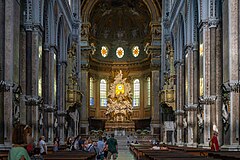Naples Cathedral
| Naples Cathedral Cathedral of the Assumption of Mary Cattedrale di Santa Maria Assunta | |
|---|---|
Neo-gothic | |
| Groundbreaking | 13th century |
| Completed | 19th century |
Naples Cathedral (
History
The present cathedral in
The Archbishop's Palace adjoins the cathedral.
Interior and artwork

The cathedral gives access to the archaeological remains in the crypt of the neighbouring original palaeochristian church of Santa Restituta where there is a Greek wall belonging to the temple of Apollo, in opus reticulatum. Under the apse the peristyle of a late imperial domus can be seen; also a stretch of Roman aqueduct after the foundation of the city and a stretch of Greek road on an inclined plane.
Another attraction of the interior is the
Other artworks include an Assumption by
The
Miracle of the Blood
The church houses a vial of the blood of Saint Januarius, which is brought out three times a year, on the first Saturday in May, on 19 September and 16 December, when the dried blood usually liquefies. If the blood fails to liquefy, then legend has it that disaster will befall Naples.
A recent hypothesis by Garlaschelli, Ramaccini, and Della Sala is that the vial contains a
Burials

- Saint Januarius
- Pope Innocent IV
- Charles I of Naples
- Saint Restituta
- Sisto Riario Sforza
- Rinaldo Piscicello
- Ascanio Filomarino
- Alfonso Castaldo
References
- ^ Garlaschelli, L.; Ramaccini, F.; Della Sala, S. (1994). "The Blood of St. Januarius". Chemistry in Britain. 30 (2): 123. Archived from the original on 26 April 2017. Retrieved 28 July 2009.
- ^ Christopher, Kevin (22 September 2000). "The Miracle Blood of Saint Januarius". Committee for Skeptical Inquiry. Archived from the original on 6 February 2007. Retrieved 2 March 2007.;
- National Geographic Channel– Riddles of the Dead – Blood Miracle
- ^ Garlaschelli, Luigi (June 2002). "Sangue prodigioso" (PDF). RICHMAC Magazine (in Italian). 84: 67–70. Archived from the original (PDF) on 12 January 2011. Retrieved 5 January 2021.
- Journal of Scientific Exploration. 6: 233–246. Archived from the original (PDF) on 17 July 2009. Retrieved 2 March 2007.[unreliable source?]
- ^ Owen, Richard (20 September 2005). "Naples blood boils at miracle's 'debunking'". The Times. London: Times Newspapers Ltd. Retrieved 2 March 2007.

